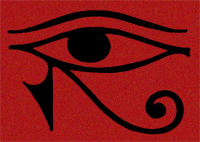 Queens of ancient Egypt outlined their eyes with kohl made from sulfide of antimony. Roman matrons rouged their cheeks with cinnabar, red mercury. Elizabethan nobles painted their faces with white lead. Victorian women swallowed arsenic to improve their complexions and drops of belladonna to dilate their eyes.
Queens of ancient Egypt outlined their eyes with kohl made from sulfide of antimony. Roman matrons rouged their cheeks with cinnabar, red mercury. Elizabethan nobles painted their faces with white lead. Victorian women swallowed arsenic to improve their complexions and drops of belladonna to dilate their eyes.
Learning these facts as a child, I developed considerable scorn for cultures of the past and their use of poisonous substances in the quest for personal beauty and hygiene. “Of course, they didn’t know any better,” I reminded myself.
Who would have dreamed that my attitude would reverse itself? At least the kohl worn by all the Egyptians who were not queens – made with lead sulfide, instead of antimony – actually protected them from eye infections. While modern concoctions . . . are not nearly so safe as we imagine. And we do know better!
Where did my change of attitude start? Strangely, with the flap about bisphenol A. My children were very young at the time, and we had plastics galore in our household. Little ones drop so many things. Surely plastic was safer than risking tender feet cut by broken glass. Well, it wasn’t; not if the plastic contained BPA, or maybe even if it didn’t. I read up on plastic and discovered that the reason it flexes the way it does is because each molecule of plastic physically slides past the others. And in the sliding process, some of the molecules are shed like skin flakes. When we eat foods stored in plastic, we eat a little of the plastic along with the food. Hmm.
I replaced all the plastic juice glasses with glass mugs. (The handles would help small fingers keep a grip.) Our tupperware and rubbermaid received the ax likewise. Canning jars and a few Pyrex containers worked just fine for storing cheese, homemade yogurt, and leftovers. Bed, Bath & Beyond even carried some inexpensive glass pitchers (with covers) for tea and milk. Good. We were set.
Except then I got to wondering . . . what else do I take for granted as safe when it isn’t? What about soap and shampoo and chapstick?
My first forays into research turned up cause for concern, but not much solid information. I decided to try the “organic” products carried by the local health food store. That was a disaster. The soap dried my skin and irritated it. The lotions were no better at moisturizing those dry hands than were conventional ones – that is, no good. And the shampoos resulted in a scalp that actually bled. Hmm again.
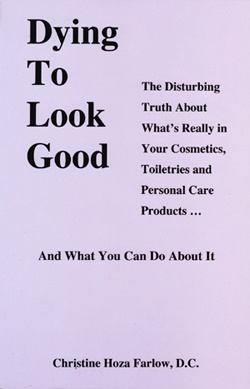 I returned to conventional products, while I did more thinking. Not much in the way of solutions came to me . . . but, eventually, I stumbled upon a little lilac-colored book: Dying to Look Good by Christine Hoza Farlow. It was still thinner on specific solutions than I wanted, but it sure gave me motivation to try again. My conventional soaps, shampoos, and lip balm were chemical cocktails of carcinogens. And the health food store versions were often little better. They just used a different chemical cocktail!
I returned to conventional products, while I did more thinking. Not much in the way of solutions came to me . . . but, eventually, I stumbled upon a little lilac-colored book: Dying to Look Good by Christine Hoza Farlow. It was still thinner on specific solutions than I wanted, but it sure gave me motivation to try again. My conventional soaps, shampoos, and lip balm were chemical cocktails of carcinogens. And the health food store versions were often little better. They just used a different chemical cocktail!
Besides providing motivation, the book also led me to the Environmental Working Group and their Skin Deep cosmetics database. I was skeptical at first. I’d already been burned by the health food stores. Would this be any better?
It was.
The database lists every single ingredient in each product it includes, and it includes a lot of products, some with ingredient lists so simple that the words are all in English, utterly bare of incomprehensible chemical terms. Those were the products I decided to try.
And I got lucky.
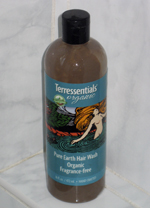 Terressentials’ hair wash, made with bentonite clay, was a beautiful thing for my hair and scalp. I’ve always had a twitchy scalp, prone to take offense at the slightest slight and throw out a patch of eczema. Apparently, the vast majority of shampoos – conventional and alternative – have ingredients that were causing my eczema. My longtime favorite also had ingredients that relieved it. But that’s crazy! To have irritant and remedy bundled together. My scalp has been calm over the last two years, ever since I slathered it in coconut oil (to soothe the damage done by the earlier experiments) and adopted the clay hair wash. (It’s not soap, and it doesn’t foam, but it does clean.)
Terressentials’ hair wash, made with bentonite clay, was a beautiful thing for my hair and scalp. I’ve always had a twitchy scalp, prone to take offense at the slightest slight and throw out a patch of eczema. Apparently, the vast majority of shampoos – conventional and alternative – have ingredients that were causing my eczema. My longtime favorite also had ingredients that relieved it. But that’s crazy! To have irritant and remedy bundled together. My scalp has been calm over the last two years, ever since I slathered it in coconut oil (to soothe the damage done by the earlier experiments) and adopted the clay hair wash. (It’s not soap, and it doesn’t foam, but it does clean.)
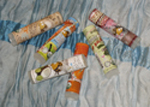 Terressentials’ lip balm was another success, although it gets a little melty in the summer. But Bubble & Bee’s lip balm tends to be too stiffly solid in the winter. So I use both, the stiff one in hot weather, the melty one in cold.
Terressentials’ lip balm was another success, although it gets a little melty in the summer. But Bubble & Bee’s lip balm tends to be too stiffly solid in the winter. So I use both, the stiff one in hot weather, the melty one in cold.
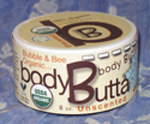 Bubble & Bee’s body butter became the first lotion to ever have a lasting effect on dry scaliness of my feet (sorry for the TMI), and it’s pretty nice on hands, elbows, and knees too. Soft, properly moist skin is the result.
Bubble & Bee’s body butter became the first lotion to ever have a lasting effect on dry scaliness of my feet (sorry for the TMI), and it’s pretty nice on hands, elbows, and knees too. Soft, properly moist skin is the result.
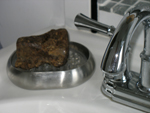 Pure castile soap from the Blue Ridge Soap Shed doesn’t undo all the good work of that body butter. And, hey, it’s local too! It’s become my husband’s favorite soap, but I prefer something even more moisturizing: African Alata soap by SheAyurvedics. They’re both good. (ETA 2015: SheAyurvedics appears to have gone out of business, alas.)
Pure castile soap from the Blue Ridge Soap Shed doesn’t undo all the good work of that body butter. And, hey, it’s local too! It’s become my husband’s favorite soap, but I prefer something even more moisturizing: African Alata soap by SheAyurvedics. They’re both good. (ETA 2015: SheAyurvedics appears to have gone out of business, alas.)
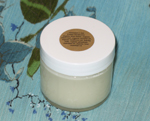 I’d had adventures with deodorants and anti-perspirants several decades ago and was leery of re-opening that can of worms. But my success with all the other toiletries, and especially with shampoo (the most unpleasant of all my cosmetic adventures) gave me courage to try again. I ordered up Bubble & Bee’s lemongrass deodorant. That proved a little too lemony for my taste, but it certainly did a fine job without irritating my skin. My husband had decided on their super pit putty, and we ended by swapping. He liked mine better, I liked his. Just recently I decided to branch out a little and purchased some lime geranium. Now my only difficulty is that I can’t decide which I like best. Both smell so nice! It’s a good problem to have.
I’d had adventures with deodorants and anti-perspirants several decades ago and was leery of re-opening that can of worms. But my success with all the other toiletries, and especially with shampoo (the most unpleasant of all my cosmetic adventures) gave me courage to try again. I ordered up Bubble & Bee’s lemongrass deodorant. That proved a little too lemony for my taste, but it certainly did a fine job without irritating my skin. My husband had decided on their super pit putty, and we ended by swapping. He liked mine better, I liked his. Just recently I decided to branch out a little and purchased some lime geranium. Now my only difficulty is that I can’t decide which I like best. Both smell so nice! It’s a good problem to have.
Two toiletries still remain begging solutions.
I hadn’t used soap on my face for years, but the gentle cleanser resting beside the bathroom sink contained questionable ingredients. My problem: nearly all the alternatives have actual soap in them. And even a mild soap is too strong for my face. The one soap-free alternative I could find also has a questionable ingredient in it: grapefruit seed extract. The extract itself is harmless, but unless it is supplied by Nutribiotics, it may be contaminated by triclosan and methyl paraben or benzethonium chloride (all big baddies).
Since the main ingredient of my one alternative was vegetable glycerin, I decided to buy that one ingredient straight up and try it. I’m finding it acceptable, but still not quite right. I’ll probably start the quest again at some point. Just not yet!
Toothpaste is my other wild child. I’m currently using one of the SLS-free Tom’s of Maine formulations, but I’m not keen on its plastic container! I’ve tried homemade: arrowroot powder mixed with a few drops of food grade mint extract. That actually was very satisfactory, but messy. I may go back to it, now that my children are older. They can handle messy these days!
So why am I telling you all these rather personal details? (Too much information, with a vengeance!) Mainly because I really wanted to find a blog post just like this 3 years ago when I embarked on my great toiletries quest. I would have been spared a bleeding scalp and a lot of aggravation. Since I didn’t find this blog post (paradoxical time travel, anyone?), I’m creating it in the hope of sparing you irritation and aggravation! Luck!
UPDATE April 2015: I discovered a mild facial cleanser that works for me – Nourish Organic Moisturizing Cream Hand Wash – and blogged about it here. I’m currently using JASON toothpaste. The tube is made of plastic (alas), but I feel confidant of the ingredients in the paste.
Castile Soap at the Blue Ridge Soap Shed
For more about safe and effective toiletries, see:
Hair Wash with Rhassoul Clay
Why Add a Lemon Rinse
Facial Soap Eureka
For more on green living, see:
Bandanna Gift Wrap
Waste-Free Lunch
Green Housekeeping

Hi Jessica,
This is great! I’ve been going through the same struggles these past few months to find healthier alternatives for soaps and shampoos. I want better health for my family, but I also want biodegradable products because some of our grey water now drains into the yard and flower garden.
What do you think of this Castile Soap?
http://caribbean-search.com/castile-beauty-soap.cfm
I’ve been using it for years and love the way it makes my skin feel, but haven’t had time to research the ingredients. Here is the list of ingredients: Sodium Tallowate, Sodium Cocoate, Water, Glycerine, Sodium Chloride, Fragrance, Titanium Dioxide, Lanolin, Citric Acid, Olive Oil and Preservatives
Disclaimer: This is my website! I sell the soap, but I do it because I have fallen in love with the product. It is much more a labour of love than an active business 😉
Thanks for your post, it has helped me! I am going to try that hair wash 😉
Great to hear from a sister traveler on this journey toward healthy alternatives. Let’s see what Dying to Look Good has to say about your soap!
:: Flipping pages to look up ::
Sodium Tallowate – not listed.
[But, this is the soap, basically! Definition: a true soap created when the fatty acid from oil or fat is combined with some type of lye, usually sodium hydroxide.]
Sodium Cocoate – not listed.
[But, this too is soap! Definition: a true soap created when the fatty acid from coconut oil is combined with some type of lye, usually sodium hydroxide.]
Water – not listed, naturally! [Good ole H2O.]
Glycerine – derived from plant or animal fats and oils.
[I’ve learned the following from reading a book on how to make your own soap: a byproduct created during soap-making; high quality soaps retain it in the soap, because it is moisturizing; low quality soaps exclude it, because it can be sold for use in other manufacturing processes.]
Sodium Chloride – natural (common table salt); skin and eye irritant.
Fragrance – manufacturers are not required to disclose chemicals used for fragrance; mostly derived from petroleum; some hazardous chemicals used in fragrance include benzyl chloride, methylene chloride, methyl ethyl ketone, methyl isobutyl ketone, phthalates, and toluene.
(Pthalates) – penetration enhancer; EPA classifies as probable carcinogen; mutagenic; may damage kidney, liver, lungs, male reproductive system; endocrine disrupter; banned in Europe.
Titanium Dioxide – generally considered safe; special cautions apply to the micronized type (smaller than skin cells) used in sunscreens.
Lanolin – derived from sheep’s wool; skin irritant; may be contaminated with carcinogenic and neurotoxic pesticides [my note: conventionally raised sheep are sprayed with pesticides]; highly purified lanolin is free of contaminants, irritants, and allergens.
Citric Acid – derived from citrus fruit or corn; if made from other than citrus fruit, may contain processed free glutamic acid (MSG).
(MSG) – When you use products on your skin that contain MSG, it is absorbed directly into your bloodstream. MSG is a neurotoxin, which means it crosses the blood brain barrier (and the placental barrier) and excites nerve cells to death. Because it affects the brain directly, it can cause a wide variety of symptoms. (Asthma attacks, rashes, migraines, etc.)
Olive Oil – may cause acne.
Preservatives – ?? not specified, so who knows?
Most of the ingredients look fine to me. I would wonder if the lanolin is either highly purified or from sheep raised without pesticide spray. Or not. I also would want to know whether the citric acid was made from citrus fruit. Or not. And what fragrances and preservatives were used? Many are quite dangerous.
The sodium cocoate is not harmful, but would be a problem for me personally. I know from reading the soap-making book that soap made from coconut oil is the most drying soap of all. Soap makers add it because it is the most foaming of soaps, and people love their lather. But it’s not the lather that gets us clean. It’s the slipperiness! Dirt and germs literally slide right off!
Soap made from olive oil is among the least drying of soaps, but it does not lather very much. Most Castile soaps are not 100% Castile, because people miss that lather! But even a hint of coconut oil tends to make a soap too drying for me, so I look for one that is made with only olive oil.
I hope that answers your question. And I hope I didn’t rain on your parade too badly! (Falling in love with a soap, yikes! Maybe I should have kept my mouth closed – er, typing fingertips, still.)
Good stuff!
No, you didn’t rain on my parade, I still think it’s better than many of the alternatives out there. Thanks for taking the time to do that!
Wow! Great blog post. Thank you for taking the time to share your journey. 🙂 I used Terresentials Mud Wash for about 3 years, loved its benefits. Although I think it may have dried my hair out over time, I’m planning to return to it though and to dilute it with aloe vera juice maybe. 🙂 Also, I complied a list of natural & organic products on my blog: http://www.lovenaturalsunshine.com/2014/10/all-natural-organic-body-care-brands.html?m=1